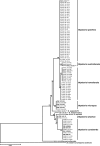Diversity of Bipolaris species in clinical samples in the United States and their antifungal susceptibility profiles
- PMID: 23052310
- PMCID: PMC3502984
- DOI: 10.1128/JCM.01965-12
Diversity of Bipolaris species in clinical samples in the United States and their antifungal susceptibility profiles
Abstract
A set of 104 isolates from human clinical samples from the United States, morphologically compatible with Bipolaris, were morphologically and molecularly identified through the sequence analysis of the internal transcribed space (ITS) region of the nuclear ribosomal DNA (rDNA). The predominant species was Bipolaris spicifera (67.3%), followed by B. hawaiiensis (18.2%), B. cynodontis (8.6%), B. micropus (2.9%), B. australiensis (2%), and B. setariae (1%). Bipolaris cynodontis, B. micropus, and B. setariae represent new records from clinical samples. The most common anatomical sites where isolates were recovered were the nasal region (30.7%), skin (19.2%), lungs (14.4%), and eyes (12.5%). The antifungal susceptibilities of 5 species of Bipolaris to 9 drugs are provided. With the exception of fluconazole and flucytosine, the antifungals tested showed good activity.
Figures


References
-
- Álvarez E, et al. 2010. Molecular phylogenetic diversity of the emerging mucoralean fungus Apophysomyces: proposal of three new species. Rev. Iberoam. Micol. 27:80–89 - PubMed
-
- Aribandi M, Bazan C. 2007. CT and MRI features in Bipolaris fungal sinusitis. Australas. Radiol. 51:127–132 - PubMed
-
- Bagyalakshmi R, Therese KL, Prasanna S, Madhavan HN. 2008. Newer emerging pathogens of ocular nonsporulating molds (NSM) identified by polymerase chain reaction (PCR)-based DNA sequencing technique targeting internal transcribed spacer (ITS) region. Curr. Eye Res. 33:139–147 - PubMed
-
- Castelnuovo P, et al. 2004. Invasive fungal sinusitis due to Bipolaris hawaiiensis. Mycoses 47:76–81 - PubMed
Publication types
MeSH terms
Substances
Associated data
- Actions
- Actions
- Actions
- Actions
- Actions
- Actions
- Actions
- Actions
- Actions
- Actions
- Actions
- Actions
- Actions
- Actions
- Actions
- Actions
- Actions
- Actions
- Actions
- Actions
- Actions
- Actions
- Actions
- Actions
- Actions
- Actions
- Actions
- Actions
- Actions
- Actions
- Actions
- Actions
- Actions
- Actions
- Actions
- Actions
- Actions
- Actions
- Actions
- Actions
- Actions
- Actions
- Actions
- Actions
- Actions
LinkOut - more resources
Full Text Sources
Medical
Molecular Biology Databases

